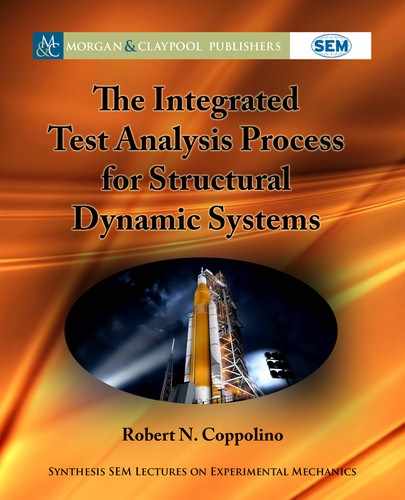58 3. SYSTEMATIC MODAL TEST PLANNING
butions; in these situations, plans for modal testing are best focused on a selected “target
mode” subset.
3.2.8 CLOSURE
A variety of target mode selection metrics for modal test planning have been explored. When
a subject system is expected to experience dynamic environments imposed as interface dynamic
motions (no other applied load sources), modal effective mass appears to provide an adequate
metric for target mode selection, as employed in the ISS P5 modal test plan and specified in
NASA STD-5002. For the more general case of a subject system expected to experience dis-
tributed applied forces (and in some cases interface dynamic motions), a detailed structural stress
and member response load (also called a loads “watch list”) modal decomposition provides the
most reliable metric for target mode selection. e “watch list” modal decomposition process
relies on Williams’ mode acceleration method and load decomposition matrices that catego-
rize stress and member response load contributions in (a) quasi-static and (b) modal dynamic
categories. As demonstrated with the axisymmetric shell finite element model, the “watch list”
decomposition process offers an effective strategy for dealing with the challenging “many modes”
problem.
3.3 PART 3: RESPONSE DOF SELECTION FOR MAPPING
EXPERIMENTAL MODES
3.3.1 INTRODUCTION
e Residual Kinetic Energy (RKE) method for response “measurement” DOF selection to
map experimental normal modes is described and demonstrated on a simple rod finite element
modal and a pre-test FEM associated with a modal test article. e method utilizes a detailed
pre-test finite element model of the subject structure. An initial response “measurement” DOF
set is first selected for mapping modes in the frequency band of interest. e remaining DOFs
of the structural model are assumed to respond in a quasi-static manner following a Guyan re-
duction transformation. Modes formed from the “measurement” partition of the FEM modal
vectors and expanded using the Guyan reduction transformation comprise the “approximate”
normal mode set. While orthogonality of the complete FEM is mathematically perfect, orthog-
onality associated with the approximate normal mode set is necessarily imperfect. e generally
accepted standard for U.S. government sponsored aerospace systems is specified by NASA and
the USAF Space Command. Residual error vectors are formed based on differences between
complete FEM normal modes in the frequency band of interest and the set of corresponding
“approximate” modes. A RKE matrix directly identifies additional DOFs (or DOF groupings)
which must be instrumented in order to experimentally map the normal modes of interest.
3.3. PART 3: RESPONSE DOF SELECTION FOR MAPPING EXPERIMENTAL MODES 59
3.3.2 SELECTION OF DOFS FOR MODAL MAPPING (THE RKE
METHOD)
e most commonly used approach for development of a TAM is Guyan eduction [3] in which
the “measurement” DOFs are retained in the “analysis” set. e matrix dynamic equations for
free vibration (with all physical constraints applied) are
Œ
K
f
ˆ
g
Œ
M
f
ˆ
g
D
f
0
g
!
K
AA
1
K
AO
K
OA
K
OO
ˆ
A
ˆ
O
M
AA
1
M
AO
M
OA
M
OO
ˆ
A
ˆ
O
D
0
0
;
(3.51)
where the FEM modal matrix is expressed in terms of “analysis” and “omitted” partitions. De-
noting the modal matrix as, Œˆ, perfect orthogonality of (unit mass normalized) modes is ex-
pressed as
Œ
OR
D
Œ
ˆ
T
Œ
M
Œ
ˆ
D
Œ
I
: (3.52)
e Guyan reduction transformation which is used to form an approximate test-analysis
mass (TAM) mass matrix is
ŒT
RED
D
I
K
1
OO
K
OA
: (3.53)
If the “analysis” set partition of the modal matrix is assumed to represent “measured”
modal DOFs, then the approximate TAM modal matrix is
ˆ
A
‰
O
D
I
K
1
OO
K
OA
Œ
ˆ
A
; (3.54)
where the partition, ‰
O
, represents the approximate “omitted” DOF partition. Moreover, the
TAM mass matrix, ŒM
AA
, is defined as
Œ
M
AA
D
I
K
1
OO
K
OA
T
M
AA
1
M
AO
M
OA
M
OO
I
K
1
OO
K
OA
: (3.55)
Imperfect orthogonality of the modal partition, Œˆ
A
, corresponding to the “measured”
DOFs with respect to the TAM mass matrix (for unit mass normalized modes, Œˆ
A
) is expressed
as,
Œ
OR
A
D
Œ
ˆ
A
T
Œ
M
AA
Œ
ˆ
A
¤
Œ
I
AA
: (3.56)
e U.S. government test mode orthogonality [1, 4] criterion requires jOR
A;ij
j 10% for
all i ¤ j terms in the TAM orthogonality matrix, ŒOR
A
.
e residual displacement error matrix based on the difference between the exact FEM
and TAM (Equation (3.54)) modal matrices is defined as
Œ
R
D
ˆ
A
ˆ
O
ˆ
A
‰
O
D
0
ˆ
O
‰
O
: (3.57)
..................Content has been hidden....................
You can't read the all page of ebook, please click here login for view all page.
